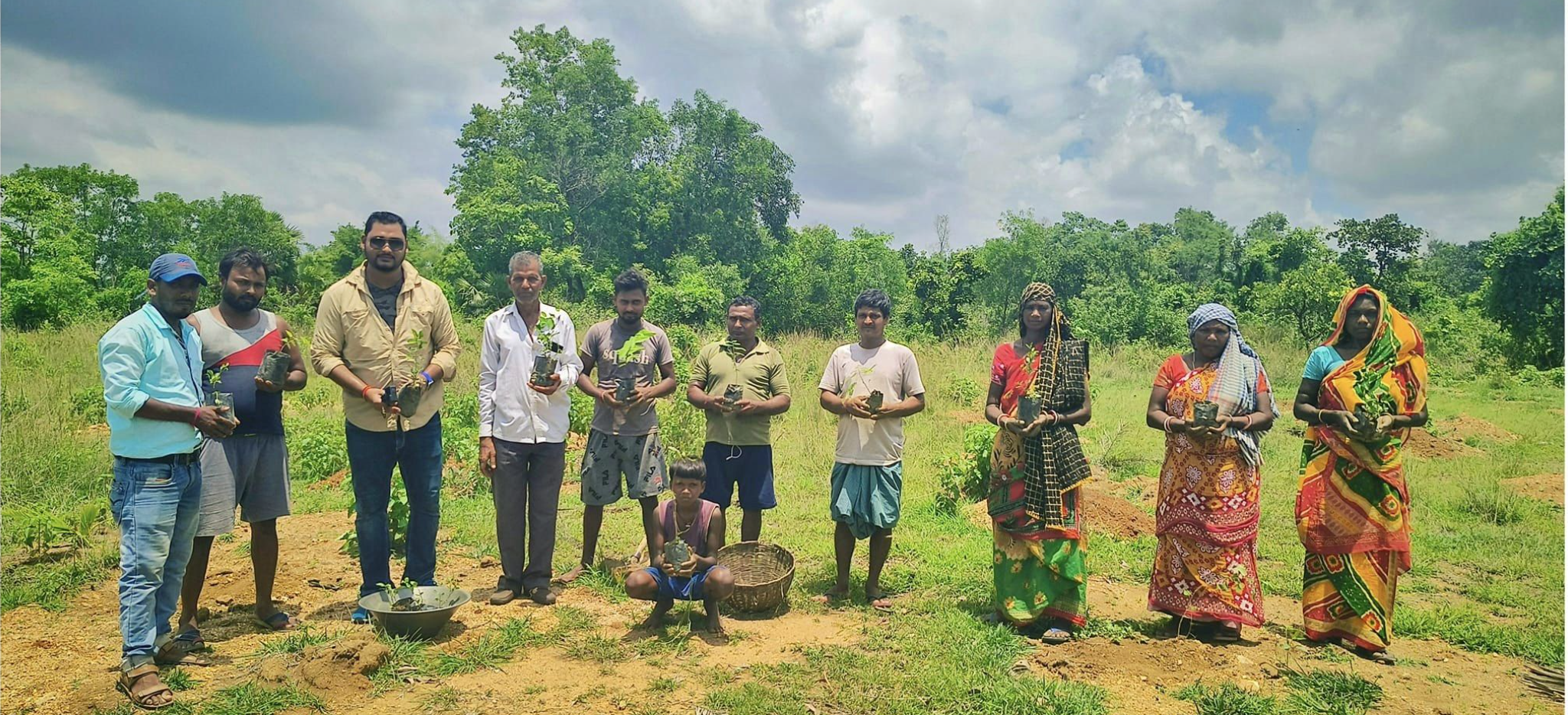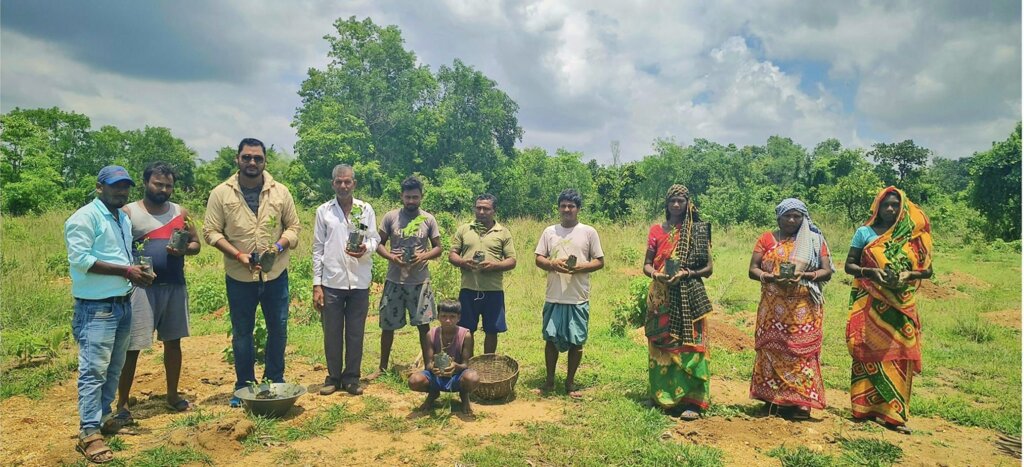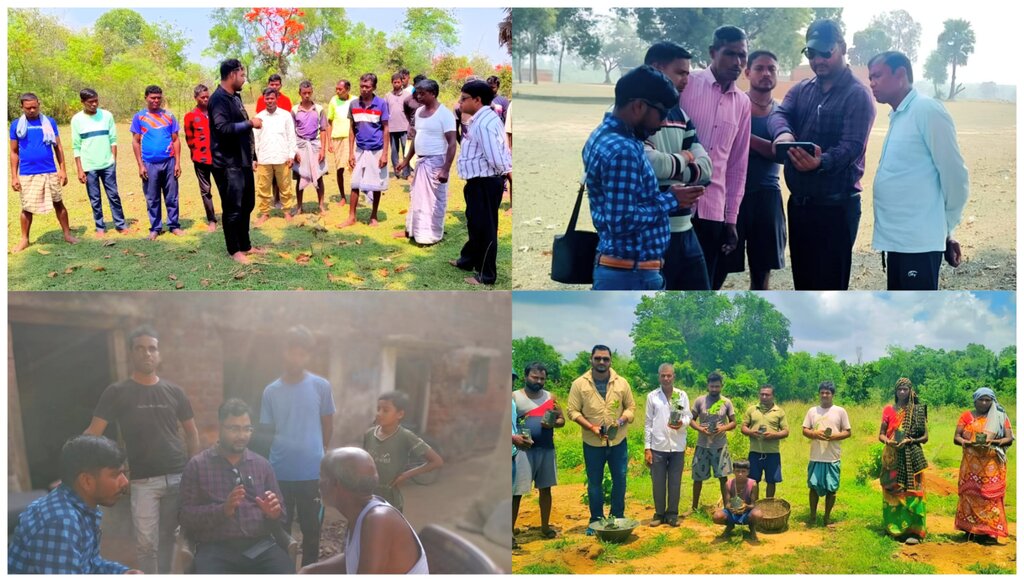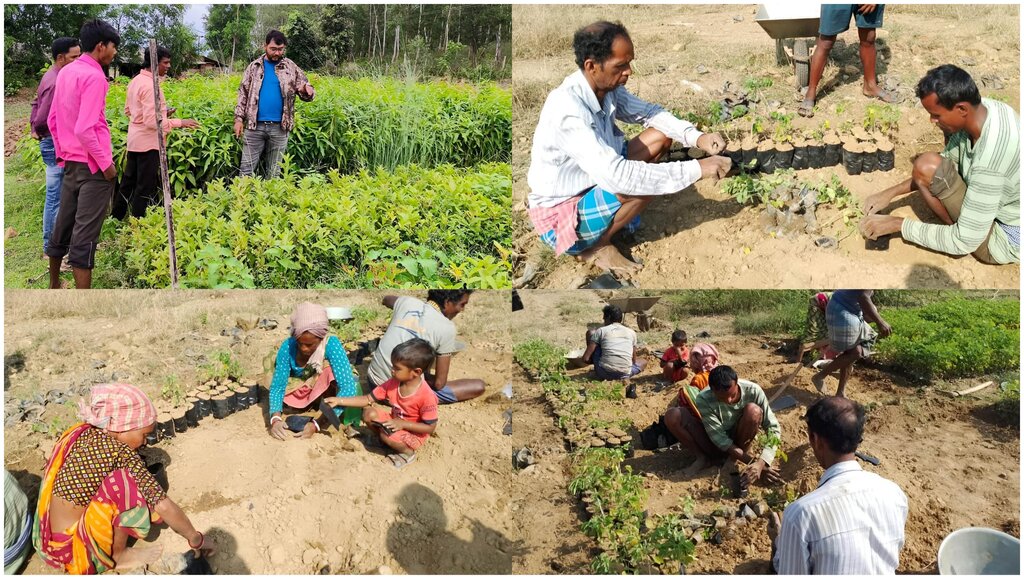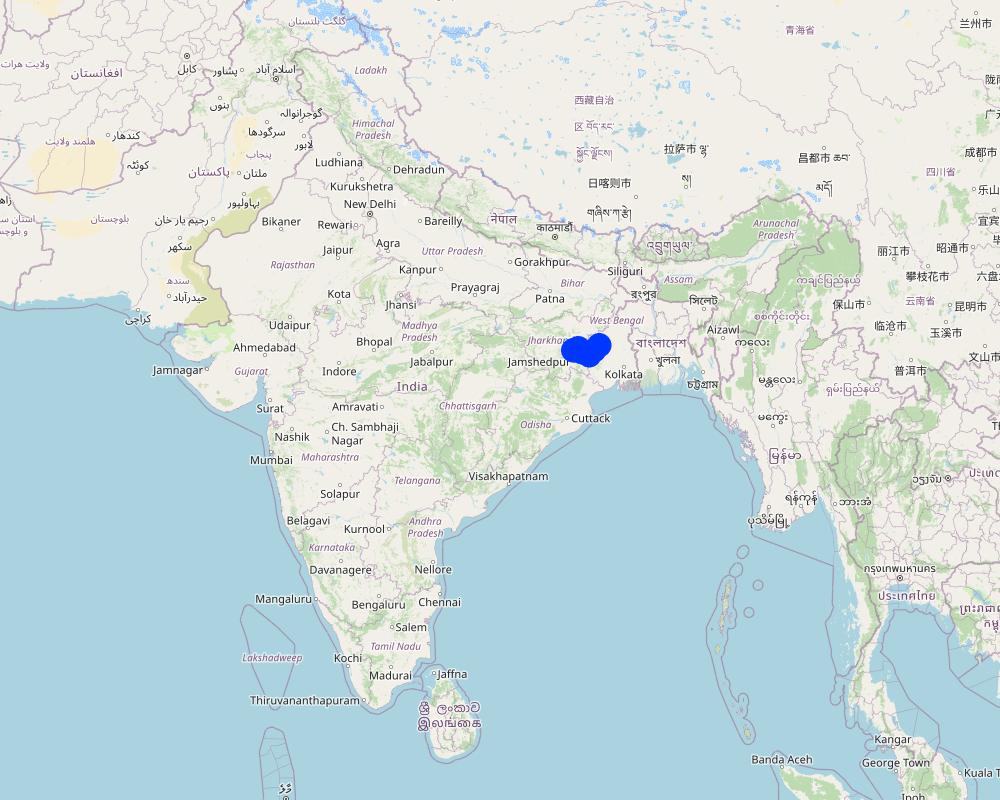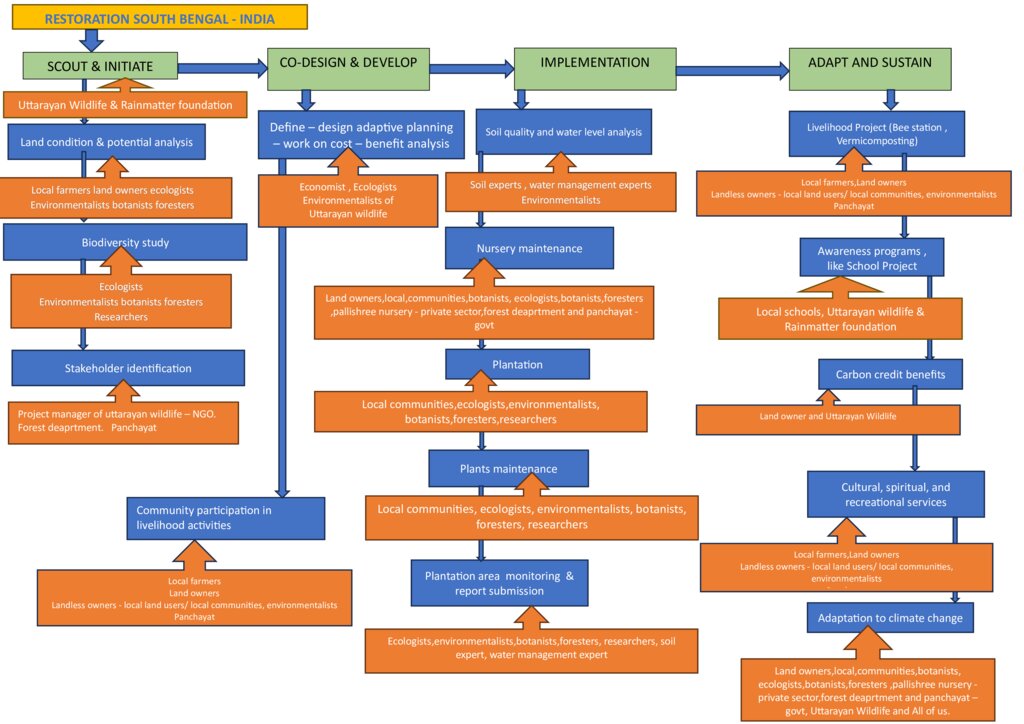Community-led participatory and self sustainable land restoration in India [India]
- Creation:
- Update:
- Compiler: DIYA BANERJEE
- Editor: –
- Reviewers: Nicole Harari, William Critchley, Rima Mekdaschi Studer
UW - RM Restoration
approaches_7117 - India
View sections
Expand all Collapse all1. General information
1.2 Contact details of resource persons and institutions involved in the assessment and documentation of the Approach
Name of project which facilitated the documentation/ evaluation of the Approach (if relevant)
Community led participatory and self sustaining degraded land restoration in West Bengal (UW - RM)Name of the institution(s) which facilitated the documentation/ evaluation of the Approach (if relevant)
Uttarayan Wildlife (UW) - India1.3 Conditions regarding the use of data documented through WOCAT
When were the data compiled (in the field)?
16/11/2021
The compiler and key resource person(s) accept the conditions regarding the use of data documented through WOCAT:
Ja
1.4 Reference(s) to Questionnaire(s) on SLM Technologies
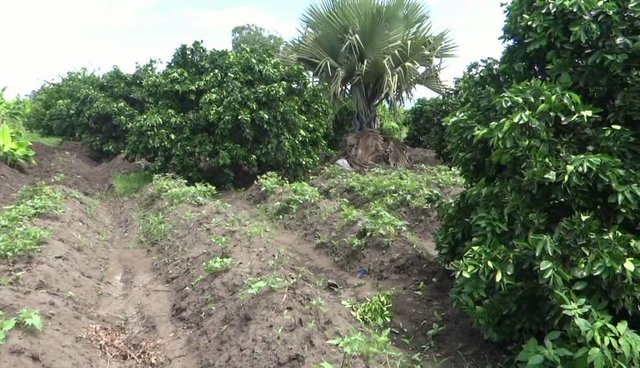
Fruit tree growing for restoration of degraded lands [Uganda]
Fruit trees of Mangoes (Mangifera indica) and Oranges (Citrus sinensis) are grown on degraded land to improve soil fertility through deep soil nutrient mining and litter of leaves.
- Compiler: Kamugisha Rick Nelson
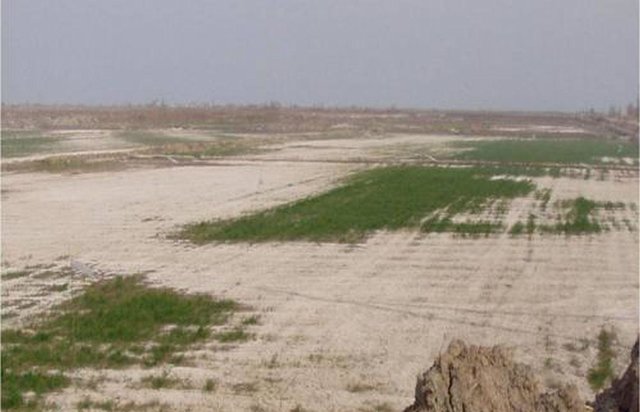
Агролесная мелиорация для реабилитации деградированных орошаемых земель (ИСЦАУЗР) [Uzbekistan]
На участке пахотной земли, не используемой из-за сильного засоления и заболачивания, создается плантация из солеустойчивых древесных пород, преимущественно с азотофиксирующей и высокой биодренажной способностью
- Compiler: Rustam Ibragimov
2. Description of the SLM Approach
2.1 Short description of the Approach
A community-led participatory approach is being implemented in West Bengal to revive and regenerate a broken and degraded landscape through sustainable land management. Local people take the lead in both action and the development of a long-term management plan.
2.2 Detailed description of the Approach
Detailed description of the Approach:
Much too long and not written as text. I have summarised and edited the language. One omission was any mention of who “we” are. I have said Uttarayan Wildlife. Is this correct? Please check that and my other edits in the following which I have entered online.
A community-led participatory approach is being implemented in West Bengal to revive and regenerate a broken and degraded landscape through sustainable land management. The approach is facilitated by Uttarayan Wildlife, an NGO. Local people take the lead in both action and the development of a long-term management plan. The identified potential/objective is sustainable and integrated business-driven landscape restoration through community participation. It is hoped to enable local communities to become part of a new generation of business professionals that will take part in integrated landscape management and business-driven landscape restoration.
The direct and indirect stakeholders involved are:
1. Local farmers, and local communities;
2. Local schools and colleges; and
3. Local government authorities
A group of facilitators guide communities in the process of recovery of damaged ecosystems. We try to guide the improvement of land towards its full potential which in our case is a traditional natural forest called Sutan – Bankura – South Bengal. It’s an approach to address a systematic crisis.
The overall goal is to achieve land degradation neutrality (LDN). With landscape restoration, that's more than just the recovery of land because a landscape is also a community. People can revitalize an area, and an economy that restores and uses the landscape with sustainable business.
We work in natural and combined zones in a mosaic restoration pattern and follow basic steps through multi-stakeholder partnerships. The sequence is as follows:
Scout and Initiate:
1. Land condition and potential – analysis and recommendations
2. Biodiversity and native forest reference studies
3. Stakeholder identification and dialogue
Co-design and co-develop:
4. Define and design adaptive planning, work on cost–benefit analyses for transformative change with TEK AND LEK and scientific study strategies/drivers for integrated landscape restoration
5.Develop an ecosystem with all possible community participation in livelihood activities
Implementation:
6. Work on:
a. Soil and water depletion
b. Seeding and plantation through nature-based solutions
c. Unsustainable grazing practices
d. Maintenance
e. Monitoring and evaluation for early learning and to adapt a theory of change
Adapt and Sustain:
7. Link livelihood activities with ecological benefits so that the community starts keeping financial capital/business in mind – and create a business case
8. A period of 20 years is minimum to see all the ‘returns’ which can be added with carbon credit benefits to make it permanent.
9. Cultural, spiritual, and recreational services
10. Adaptation to climate change
Scaling up and replication is the ultimate objective – and we will hand-over to the local community using “exit policies”, allowing entrepreneurs/farmers to develop the right skills and knowledge to independently run successful restoration businesses. We hope to scale this model beyond state boundaries with similar issues and potentials. Throughout, we will practice a public – private - partnership (PPP) to strike the right collaborations and partnerships for an efficient Business Model Canvas in order to achieve successful sustainable ecosystem restoration with the community.
In the initial stage local stakeholders were very wary in terms of trust and faith since they were voluntarily pledging their land, time and resources. With time as the model was tested successfully there has been participation from all quarters.
2.3 Photos of the Approach
General remarks regarding photos:
Since most efforts are community participatory-led, this gives the local sense of ownership and sustenance making it long term sustainable.
2.4 Videos of the Approach
Comments, short description:
https://www.youtube.com/watch?v=MASkUcKPcUU&t=89s&ab_channel=UttarayanWildlife
Our last two years of activities in a snapshot!
Date:
01/11/2023
Location:
Ranibund , Gorshika, Jhilimili, Dhatala, Kechonda, Ayodhya. Bankura and Purulia
Name of videographer:
Atin Chatterjee
Comments, short description:
https://www.youtube.com/watch?v=hZri4LpAYOQ&ab_channel=UttarayanWildlife
This is a Before and After Plantation feedback from the local farmers!
Date:
13/12/2023
Location:
Gorshika - Purulia
Name of videographer:
Atin Chatterjee
2.5 Country/ region/ locations where the Approach has been applied
Country:
India
Region/ State/ Province:
West Bengal
Further specification of location:
Bankura, Purulia
Map
×2.6 Dates of initiation and termination of the Approach
Indicate year of initiation:
2021
Year of termination (if Approach is no longer applied):
2027
Comments:
Its a 5 year long approach to empower the locals to continue for the next 10-20 years.
2.7 Type of Approach
- project/ programme based
2.8 Main aims/ objectives of the Approach
Sustainable and Integrated landscape management and business-driven landscape restoration of degraded ecosystems and landscapes with community participation - enable local communities to become part of a new generation of business professionals that will take part in integrated landscape management and business-driven landscape restoration in a long term sustainable way.
2.9 Conditions enabling or hindering implementation of the Technology/ Technologies applied under the Approach
social/ cultural/ religious norms and values
- enabling
The in-built social and religious belief of nature being good enables the project to penetrate easily among locals.
- hindering
The traditional practice of paddy cultivation which presently is of very low yield and loss making but the older generation would not like to try the new agroforestry method or multi cropping system which will regenerate the soil increasing cultivation.
availability/ access to financial resources and services
- enabling
Since its in a start-up mode with investment from Corporate Social Responsibility funds(this is a mandate from India government to all companies running business in India), it enables the project to penetrate smoothly.
institutional setting
- enabling
The ground level institutional setting in villages have helped us to communicate, facilitate and implement since locals understand the long term benefit.
collaboration/ coordination of actors
- enabling
The local farmers, landless labours, schools and colleges, local panchayats coordinate to procure degraded land, participate together to form committees and do long term maintenance of their planted lands.
legal framework (land tenure, land and water use rights)
- enabling
We dont have any formal legal tenure since its a voluntary and participatory mode to procure land from land owners. This enables us to build trust with the locals.
policies
- enabling
We together with locals adhere to basic country level and land level policies.
land governance (decision-making, implementation and enforcement)
- enabling
Land governance is wholly in the hands of the land owners including all aspects of decision-making, implementation and enforcement. We just enable and empower.
knowledge about SLM, access to technical support
- enabling
Most of the ecology knowledge is derived from our local farmers and their deep understanding of land, soil, water and plants. We also have a team of botanists and ecologists who have done extensive biodiversity study for reference. We have consultant scientists on soil, plants, water levels.
markets (to purchase inputs, sell products) and prices
- enabling
Target markets are the locals or district level or the nearest big town. Most of our livelihood empowerment would be locally used and sold locally too.
- hindering
Transport cost would be the only hindrance with respect to sending local produce in far away markets.
workload, availability of manpower
- enabling
Availability of man power is onus of the local committee which mostly makes the process smoother.
- hindering
There are cultivation seasons, festivals which hinder the process now and then but its not a show stopper.
3. Participation and roles of stakeholders involved
3.1 Stakeholders involved in the Approach and their roles
- local land users/ local communities
Local farmers
Land owners
Landless owners
Equal participation
- SLM specialists/ agricultural advisers
Soil experts
Water management experts
Botanists
Ecologists
Planning
Expert mitigation advise
- researchers
Environmentalists
Botanists
Foresters
Biodiversity study
Plant health study
New approach
- teachers/ school children/ students
Teachers
School management
Students
Participate in nature awareness, walks, knowing biodiversity
Plantation drives
- NGO
Uttarayan Wildlife
Main implementation
- private sector
Rainmatter Foundation
Pallishree Nursery
Funding
Expert consultation
- local government
Forest Department
Panchayat
Data support
Community Support
If several stakeholders were involved, indicate lead agency:
NGO - Uttarayan Wildlife
3.2 Involvement of local land users/ local communities in the different phases of the Approach
| Involvement of local land users/ local communities | Specify who was involved and describe activities | |
|---|---|---|
| initiation/ motivation | self-mobilization | Local farmers and committees: Voluntary participation in pledging their degraded lands for the program to revive and restore. UW approached with the plan. Participate in initiating the program and motivating other farmers to join. |
| planning | interactive | Together with our SLM expert team, the locals interact and plan areas of plantation, use and share their traditional knowledge to mark areas of water, soil quality, cattle grazing and accordingly the plantation map is planned. |
| implementation | interactive | To implement the plan the locals/stakeholders involved create local committees to organise labourers, local resources for a smooth implementation. |
| monitoring/ evaluation | self-mobilization | The local committees are responsible for taking care of plants - watering, checking on health and reporting, creating barriers against cattle grazings, fire etc. They implement their own mulching techniques and use organic fertiliser to safe guard plants. Due to local participation the mortality rate of plants have been less than 20% which is global standard. |
| external support | We harness expertise of biologists, botanists to document the process and inspect time to time. |
3.3 Flow chart (if available)
Description:
The above flow chart shows the approach/methodology and the various stakeholders involved at each stage
Author:
Diya Sur
3.4 Decision-making on the selection of SLM Technology/ Technologies
Specify who decided on the selection of the Technology/ Technologies to be implemented:
- mainly land users, supported by SLM specialists
Explain:
Its a joint partnership in deciding and planning the use of technology/methodlogy as per the condition of the land and weather.
Specify on what basis decisions were made:
- evaluation of well-documented SLM knowledge (evidence-based decision-making)
- research findings
- personal experience and opinions (undocumented)
4. Technical support, capacity building, and knowledge management
4.1 Capacity building/ training
Was training provided to land users/ other stakeholders?
Ja
Specify who was trained:
- land users
- field staff/ advisers
If relevant, specify gender, age, status, ethnicity, etc.
Local farmers of different age, social status are trained including women. Gender split is 40:60(women and men consecutively)
Form of training:
- on-the-job
- farmer-to-farmer
- demonstration areas
- public meetings
Subjects covered:
1. Program planning and use of technology/methodology
2. Soil testing
3. Biodiversity checking
4. Vermicompost creation
5. Standard operating procedure for plantation maintenance
6. Bee station maintenance
Comments:
Locals absorb very well and show enthusiasm and share their traditional experiences.
4.2 Advisory service
Do land users have access to an advisory service?
Ja
Specify whether advisory service is provided:
- on land users' fields
Describe/ comments:
Develop SOP as taught by ecology experts for plantation and maintenance of plantation areas and nursery.
Testing soil conditions by soil experts
Biodiversity surveys to check on environmental health of the surroundings with botanists and biologists
Expert foresters help in planning plantation as per land and water conditions
4.3 Institution strengthening (organizational development)
Have institutions been established or strengthened through the Approach?
- yes, moderately
Specify the level(s) at which institutions have been strengthened or established:
- local
Describe institution, roles and responsibilities, members, etc.
Local farmers have set up voluntary committees to participate and implement and maintain degraded land restoration.
Specify type of support:
- financial
- capacity building/ training
Give further details:
Program has financial support from CSR funds - Rainmatter Foundation and local knowledge and expertise support from Pallishree including capacity building. We have external partners for support on biodiversity surveys, bee keeping.
4.4 Monitoring and evaluation
Is monitoring and evaluation part of the Approach?
Ja
Comments:
We have SOP created and checklists for monitoring and management level evaluations. We do periodic inspections with our external experts to check on the health of the program.
If yes, is this documentation intended to be used for monitoring and evaluation?
Ja
Comments:
The SOP and checklists are used for the monitoring and evaluation.
4.5 Research
Was research part of the Approach?
Ja
Specify topics:
- ecology
Give further details and indicate who did the research:
We did an extensive biodiversity and phenology research which was carried out by our partner organisation with their botanists, ecologists and foresters for one year. The research paper is being published in ecology forums and science journals.
5. Financing and external material support
5.1 Annual budget for the SLM component of the Approach
If precise annual budget is not known, indicate range:
- 10,000-100,000
Comments (e.g. main sources of funding/ major donors):
Rainmatter Foundation - Corporate social Responsibility (its a Government of India social mandate to all profit making companies in India to contribute 2% of their net profit to socially responsible programs run by NGO's.
Rainmatter Foundation is a Zerodha(brokerage firm) outfit of CSR.
5.2 Financial/ material support provided to land users
Did land users receive financial/ material support for implementing the Technology/ Technologies?
Ja
If yes, specify type(s) of support, conditions, and provider(s):
They received plants, land preparation, fertiliser, materials to start their livelihood like vermicompost from the program funding.
5.3 Subsidies for specific inputs (including labour)
- none
If labour by land users was a substantial input, was it:
- paid in cash
Comments:
Rates were as per Indian labour laws.
5.4 Credit
Was credit provided under the Approach for SLM activities?
Nee
5.5 Other incentives or instruments
Were other incentives or instruments used to promote implementation of SLM Technologies?
Nee
6. Impact analysis and concluding statements
6.1 Impacts of the Approach
Did the Approach empower local land users, improve stakeholder participation?
- No
- Yes, little
- Yes, moderately
- Yes, greatly
Since its a community driven participatory program, we engage our land and ecologist experts in a dialogue with the locals to identify specify local problems with land degradation and find the most sustainable solution and long term benefits and with our start-up help locals are empowered to implement the solutions in their land in a sustainable way. Such collaborative engagement leads to improved stakeholder participation.
Did the Approach enable evidence-based decision-making?
- No
- Yes, little
- Yes, moderately
- Yes, greatly
Local traditional evidence based knowledge pertaining to the specific land coupled with our biodiversity survey of nearby reference native forests by our ecology experts makes it easier to make informed decision of land management based on evidence.
Did the Approach help land users to implement and maintain SLM Technologies?
- No
- Yes, little
- Yes, moderately
- Yes, greatly
As planned and designed by scientific experts and locals specially on forest land management, agroforestry as an approach for degraded land restoration, it was helpful to implement and maintain the SLM technologies since the approach is jointly agreed upon.
Did the Approach improve coordination and cost-effective implementation of SLM?
- No
- Yes, little
- Yes, moderately
- Yes, greatly
Since its a joint management with locals and program experts, coordination is institutionalized and seemless. Due to close coordination, land procurement happens in bigger portions making it cost effective to implement the SLM technologies and manage in long run.
Did the Approach improve knowledge and capacities of land users to implement SLM?
- No
- Yes, little
- Yes, moderately
- Yes, greatly
Most of the SLM technologies are indigenous
Did the Approach improve knowledge and capacities of other stakeholders?
- No
- Yes, little
- Yes, moderately
- Yes, greatly
The local stakeholders have a fair amount of traditional knowledge of land management, reasons for soil degradation or even climatic changes. Our experts with their scientific knowledge enhanced local knowledge and traditional beliefs with evidence based theories. Our team experts and local stakeholders learn from each other and we have regular learning sessions enhancing the program on field. https://youtu.be/YJxOtm6qh-c?si=IR4M4LzOxINBVO7h
Did the Approach build/ strengthen institutions, collaboration between stakeholders?
- No
- Yes, little
- Yes, moderately
- Yes, greatly
The community led approach built strong local committees who collaborate to plan, design and implement the program together with industry experts from our program team
Did the Approach mitigate conflicts?
- No
- Yes, little
- Yes, moderately
- Yes, greatly
In the initial days of the program, we have witnessed many conflicts arising out of jealousy between landowners whose land is being rewilded and landless people resulting in deliberate plant destruction. Later we changed the approach to include landowners and landless people to form committees and help each other to build and implement the approach reducing conflicts. One of our other goal is also to reduce man-elephant conflict by creating natural habitats for elephants to rest and eat fodder rather than raiding crops.
Did the Approach empower socially and economically disadvantaged groups?
- No
- Yes, little
- Yes, moderately
- Yes, greatly
The approach is inclusive and doesnt distinguish with landowners or landless people who are largely socially and economically disadvantaged groups and we try to keep a diverse stakeholder base considering minorities, tribals etc.
Did the Approach improve gender equality and empower women and girls?
- No
- Yes, little
- Yes, moderately
- Yes, greatly
Our nursery is mostly women driven and they get employment. We encourage girls from nearby schools to participate in plantation activities.
Did the Approach encourage young people/ the next generation of land users to engage in SLM?
- No
- Yes, little
- Yes, moderately
- Yes, greatly
Our special mini program under the main Restoration one is to encourage, empower youth/next generation with climate and nature studies, involve them in restoration work in-field and create micro mini ecosystems in their schools for them to nurture. Our goal is to nurture a generation of nature champions who all will carry this movement forward. https://youtu.be/bX4xK6-fnDs?si=ZkwJdV4LmZgq_MUP
Did the Approach lead to improved food security/ improved nutrition?
- No
- Yes, little
- Yes, moderately
- Yes, greatly
We address SDG 1 and 2 by creating fruit forest as a food bank/security during times of severe draught which are common in arid regions.
Did the Approach lead to more sustainable use/ sources of energy?
- No
- Yes, little
- Yes, moderately
- Yes, greatly
We use solar energy for all our energy needs specially in nursery.
Did the Approach improve the capacity of the land users to adapt to climate changes/ extremes and mitigate climate related disasters?
- No
- Yes, little
- Yes, moderately
- Yes, greatly
One of the bigger goal of this program is to work closely with climate refugees( the local farmers) who are facing harsh climatic conditions, less cultivation/yield, economic slowdown leading to them turning into migration laborers to mitigate climatic disasters like draught due to land degradation. The program wholly addresses land degradation neutrality to enhance soil quality, water levels, increased chances of cultivation through agro-forestry thus mitigating climate related disasters.
Did the Approach lead to employment, income opportunities?
- No
- Yes, little
- Yes, moderately
- Yes, greatly
The program employs directly and indirectly more than 1200 locals in land preparation, nursery, plantation work boosting local economy.
6.2 Main motivation of land users to implement SLM
- increased production
Addressing soil degradation, strategic plantation leads to regeneration of health of land and increased fruit and food production
- increased profit(ability), improved cost-benefit-ratio
The fruit trees and other economically beneficial trees like bamboo etc increases profitability and cost-benefit ration in the long run
- reduced land degradation
Soil and water reclamation and plantation reduces land degradation
- reduced risk of disasters
Soil and water reclamation and plantation reduces land degradation and reduced risk of climatic disasters
- environmental consciousness
Locals are environment conscious in their own capacity so empowering them helps to strengthen their belief.
- enhanced SLM knowledge and skills
Together with their traditional knowledge and skills of land management, expert trainings and advise helps to enhance SLM knowledge and skills.
- aesthetic improvement
Presently hectares of unused barren land makes the area look bare so the approach will rewild and make the area look greener with revived biodiversity.
- conflict mitigation
Man-man conflict and man-elephant conflict mitigations are few of the outcomes of the approach.
6.3 Sustainability of Approach activities
Can the land users sustain what has been implemented through the Approach (without external support)?
- yes
If yes, describe how:
With an increased cost-benefit ratio in the long term, creation of food bank and increased cultivation due to land degradation neutrality, the locals would be in a better position to carry forward the approach in a sustainable way without any external support. The approach acts as a start-up kit for a better greener future.
6.4 Strengths/ advantages of the Approach
| Strengths/ advantages/ opportunities in the land user’s view |
|---|
|
https://youtu.be/hZri4LpAYOQ?si=twd2yJoek0U1n1B6 As told by the local stakeholders, in past 3 years of the approach/program, they have clearly witnessed land regeneration. |
| They are satisfied by the equal opportunity to plan and design and use their traditional knowledge and skills, reduced man-man conflicts since they work in committees and learning new approaches. |
| They are very happy about increased potential of cultivation and local income. |
| Strengths/ advantages/ opportunities in the compiler’s or other key resource person’s view |
|---|
| The approach being community-led, creates a sense of joint land management reducing internal conflicts and working towards a better future. |
| By achieving land degradation neutrality, regeneration boosts local economy impacting as a watershed, better children's education, more strong local policies towards mitigating climatic extreme conditions. |
| What started as a program has now turned into a local community led movement to uplift land degradation and reduce climate disaster and regenerate biodiversity. |
6.5 Weaknesses/ disadvantages of the Approach and ways of overcoming them
| Weaknesses/ disadvantages/ risks in the land user’s view | How can they be overcome? |
|---|---|
| Natural disasters like widespread fire destroying plantations | Create trenches and fire lines to stop spreading |
| Severe climatic condition like drought which makes it impossible to nurture the plants | Create water trenches and regenerate local water sources |
| Weaknesses/ disadvantages/ risks in the compiler’s or other key resource person’s view | How can they be overcome? |
|---|---|
| Natural disasters like widespread fire destroying plantations | Create trenches and fire lines to stop spreading |
| Severe climatic condition like drought which makes it impossible to nurture the plants | Create water trenches and regenerate local water sources |
7. References and links
7.1 Methods/ sources of information
- field visits, field surveys
10-12
- interviews with land users
5-6
- interviews with SLM specialists/ experts
3-4
- compilation from reports and other existing documentation
2
7.2 References to available publications
Title, author, year, ISBN:
NA( will be published soon)
7.3 Links to relevant information which is available online
Title/ description:
Program/NGO website
URL:
www.uttarayanwildlife.org
Title/ description:
NGO channel
URL:
https://www.youtube.com/channel/UC7q6Ii0lVAUvfDYlsKDMGuQ
Title/ description:
News articles
URL:
https://www.thehindu.com/news/national/other-states/elephant-corridors-to-be-restored-in-south-bengal/article38316050.ece
Title/ description:
News articles
URL:
https://timesofindia.indiatimes.com/city/kolkata/5-year-habitat-restoration-plan-for-south-bengal-jumbo-corridors/articleshow/92447156.cms?utm_source=whatsapp&utm_medium=social&utm_campaign=AmpArticleshowicon&fbclid=IwAR3PFI1eoB9eIPgTxftiO_AV7iBDeO2rc-pf-ByvQGlDMfoFauSSCeiS1FU
Title/ description:
News articles
URL:
ttps://www.thehindu.com/news/national/other-states/elephant-corridors-to-be-restored-in-south-bengal/article38316050.ece?homepage=true
Links and modules
Expand all Collapse allLinks

Fruit tree growing for restoration of degraded lands [Uganda]
Fruit trees of Mangoes (Mangifera indica) and Oranges (Citrus sinensis) are grown on degraded land to improve soil fertility through deep soil nutrient mining and litter of leaves.
- Compiler: Kamugisha Rick Nelson

Агролесная мелиорация для реабилитации деградированных орошаемых земель (ИСЦАУЗР) [Uzbekistan]
На участке пахотной земли, не используемой из-за сильного засоления и заболачивания, создается плантация из солеустойчивых древесных пород, преимущественно с азотофиксирующей и высокой биодренажной способностью
- Compiler: Rustam Ibragimov
Modules
No modules


